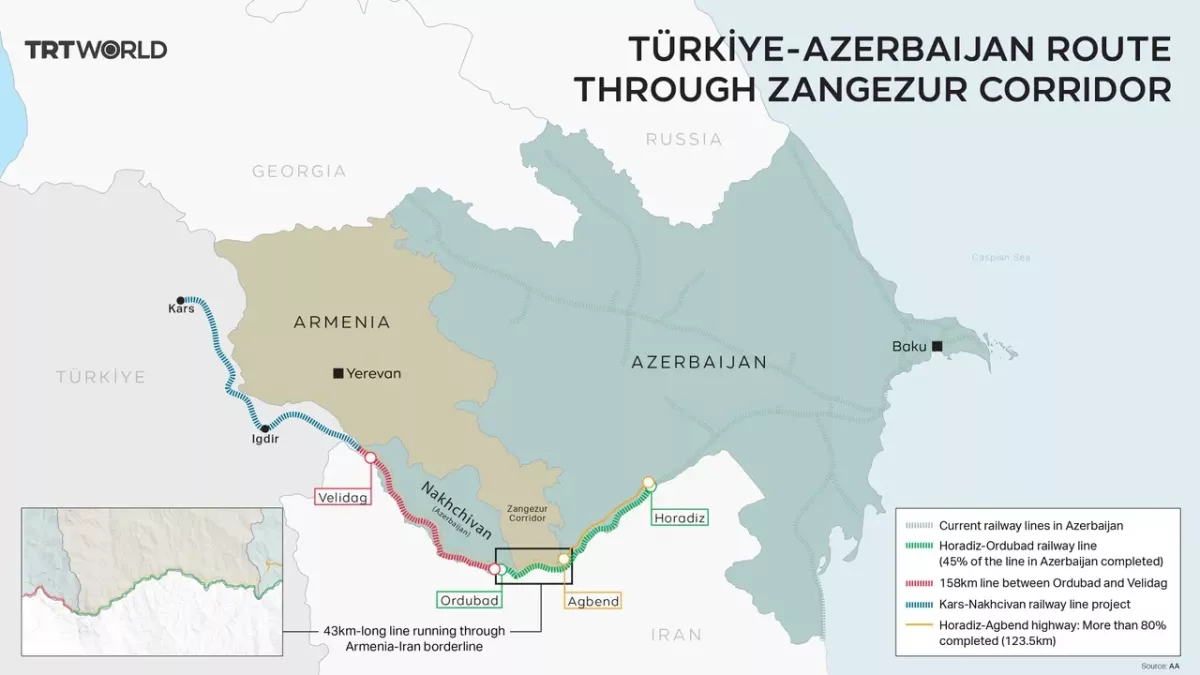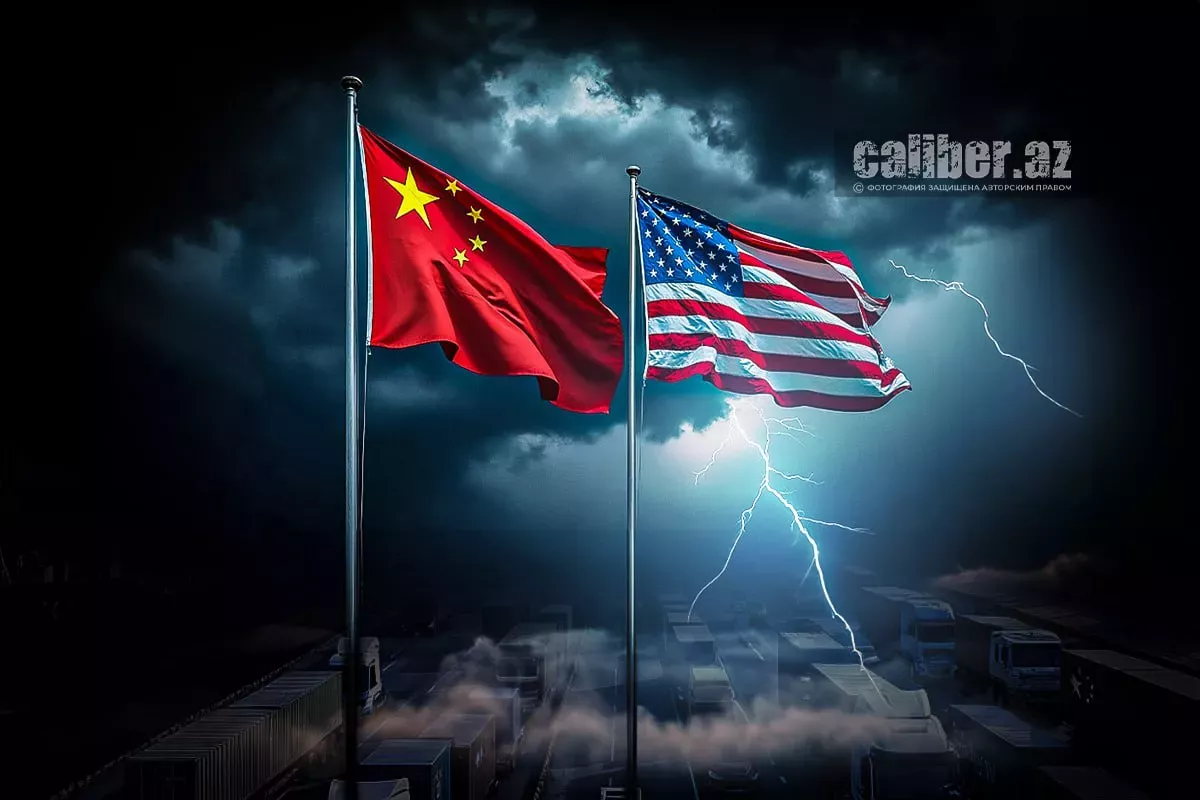Zangezur Corridor: Where US, China, Türkiye interests converge Article by TRT World
Turkish TRT World news outlet has published an article dedicated to the Zangezur Corridor. Caliber.Az reprints some parts of the article with minor modification.
“Under the Washington peace deal between Azerbaijan and Armenia, the US secured a 99-year mandate to oversee the Zangezur Corridor, a move that reshapes Eurasian geopolitics.
The corridor is now positioned not only as the backbone of the Middle Corridor trade route but also as a guarantor of cooperation and prosperity.
Its significance, however, extends well beyond the Caucasus.
By linking East and West while bypassing both Russia and Iran, it provides Europe and Asia with a resilient trade lifeline.
Its natural alignment with China’s Belt and Road Initiative (BRI) intersects with Washington’s efforts to counter Beijing’s influence.
The critical question is whether the US and China can forge a modus vivendi [way of living - ed.] around this artery, or whether it becomes another front in their strategic rivalry.
Rewiring of Eurasian connectivity
The Zangezur Corridor is more than just a strip of infrastructure; it is a geopolitical hinge.
Proposed by Baku and backed decisively by Ankara, the corridor links mainland Azerbaijan with its Nakhchivan exclave through southern Armenia.
In doing so, it not only bridges two Azerbaijani territories but also anchors a broader Turkic world connectivity stretching from Central Asia to Europe.

For the South Caucasus states, the Zangezur Corridor is not just asphalt and steel; it is an entry ticket into deeper economic integration.
Armenia and Azerbaijan stand to gain from the stability and investment tied to a functioning east–west artery.
For a region scarred by frozen conflicts, the promise of transit revenue, logistics hubs, and connectivity to Europe offers a rare incentive for cooperation rather than confrontation.
For Central Asia, the stakes are even higher. Landlocked economies such as Kazakhstan, Uzbekistan and Turkmenistan depend on reliable corridors to reach global markets.
Zangezur, as part of the Trans-Caspian route, provides precisely that, a way to link Central Asia’s resources and industries to Europe.
By cutting across the South Caucasus and Türkiye, it offers a pathway that is far less vulnerable to the political risks associated with Moscow’s war in Ukraine or Tehran’s tensions with the West.
The road to peace and prosperity
For Türkiye, this is the culmination of decades of strategic investment: from the Baku–Tbilisi–Ceyhan pipeline to the Eurasia Tunnel, the Yavuz Sultan Selim Bridge, and the Edirne–Kars high-speed railway.
Ankara’s long bet on connectivity is now paying off, positioning Türkiye as the indispensable hub of Eurasia’s arteries.
Alternative routes faltered. The Southern Corridor through Iran remains insecure due to instability and Tehran’s international isolation. While the Northern Corridor via Russia once carried over 86 percent of China-Europe trade, the Ukraine war turned it into a financial and political liability.
Yet infrastructure alone is not enough. Diplomacy and lasting peace are essential.
Perhaps the most surprising development is Armenia’s recalibration.
By shaking hands with Baku, Yerevan has embraced a pragmatic foreign policy shift. What once seemed unimaginable, Yerevan integrating itself into a Turkic-led connectivity project, has now become a reality.
By embracing the corridor, Armenia is not surrendering sovereignty but buying itself relevance in Eurasia’s trade map. The payoff could be significant: reduced dependency on Russia, greater access to investment, and a new role as a contributor rather than an obstacle to regional integration.
This shift does not erase tensions, but it signals that even Armenia, once viewed as the corridor’s greatest obstacle, has recognised the geoeconomic logic of connectivity. In the emerging Eurasian order, pragmatism may be Yerevan’s best strategy to move forward.
Any discussion of the Zangezur Corridor must be situated in the wider framework of China’s Belt and Road Initiative (BRI).
Since its launch in 2013, BRI has sought to weave a lattice of land and maritime routes connecting China to Europe.
Until now, the Middle Corridor has remained the underdeveloped cousin of the dominant northern rail lines through Russia and the southern maritime routes via the Indian Ocean.
Zangezur changes this calculus. By embedding Armenia and Azerbaijan into the Trans-Caspian artery, it strengthens the Middle Corridor as a credible alternative.
For Beijing, the corridor offers precisely what its planners seek: a resilient path that sidesteps US-controlled chokepoints at sea and the political risks of overdependence on Moscow.
In that sense, Zangezur was to be less a detour than a strategic hinge, a missing piece in China’s Eurasian puzzle.

For Washington, controlling the corridor is a strategic win, securing influence over the most viable BRI land route into Europe. On the other hand, if Washington settles for such a narrow calculation, it will only squander Zangezur’s potential as the key to East–West connectivity, with the opportunity cost all the greater.
At the crossroads of multipolarity
At its core, the question remains: can Washington and Beijing cooperate over Zangezur, or will it become another fault line of their rivalry?
The corridor’s pivotal role in East–West connectivity is self-evident for China, which sees it as a natural complement to the BRI. Yet the United States, with its latest moves, looks to hold the key: aligning the corridor with European energy security, embedding its regional policies more firmly, and simultaneously weakening Russian and Iranian influence across the South Caucasus and beyond.
The Zangezur Corridor is thus more than a road: it is a microcosm of US–China relations. At one extreme, it can be weaponised into a zero-sum contest; at the other, it can serve as a shared artery of interdependence — proof that even rival superpowers can cooperate when global connectivity is at stake.
Cooperation is possible, even desirable, but hardly guaranteed. Yet a modus vivendi could still be forged: competition elsewhere, but coordination here, where both stand to gain.
If such an arrangement is achieved, Zangezur could transcend its geography. It would carry not only goods, but also the prospect of a peace–stability–prosperity triangle that resonates far beyond the South Caucasus.
Here, Türkiye emerges as the indispensable integrator — the actor capable of translating US governance and oversight, EU standards, and Chinese demand into workable throughput.
Its decades of investment in pipelines, railways, and cross-continental infrastructure now give Ankara both the political leverage and logistical capacity to act as the corridor’s operational mediator.
In this light, a trilateral compact — Washington shaping the rules, Türkiye managing integration, and Beijing contributing utilisation and co-financing — could transform rivalry into managed interdependence.
The Zangezur Corridor will therefore be remembered either as the backbone of multipolar cooperation or as the next battlefield of renewed division.
To avoid the latter, Washington and Beijing must engage pragmatically, turning a contested passage into a cooperative artery,” the article reads.








